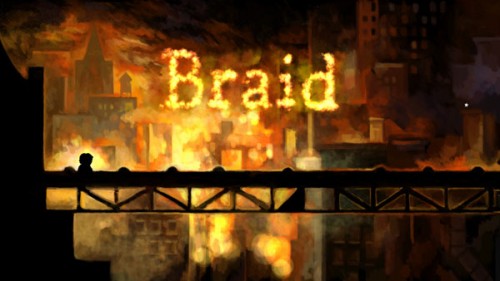
The hallmark of a great ‘casual’ game is that it takes elements from existing game types, wraps them around a new or innovative gameplay twist, and turns it all into something that feels fresh. It is how games like Plants vs. Zombies or Puzzle Quest take the existing gameplay from the Tower Defense and Match 3 genres respectively and turn them into engaging and addictive games that feel completely original. Today I look at another game that looks to join ranks with those by taking a fresh approach to another well-worn genre: platform games as re-imagined by developer Jonathon Blow in the game Braid.
Braid originally came out for XBOX Live Arcade in August of last year, and was released for the PC in mid-April and the Mac at the beginning of June. The occasion of the Mac release finally pushed me to grab a copy!
The Hype:
Braid is a puzzle-platformer, drawn in a painterly style, where the player manipulates the flow of time in strange and unusual ways. From a house in the city, journey to a series of worlds and solve puzzles to rescue an abducted princess. In each world, you have a different power to affect the way time behaves, and it is time’s strangeness that creates the puzzles. The time behaviors include: the ability to rewind, objects that are immune to being rewound, time that is tied to space, parallel realities, time dilation, and perhaps more. Braid treats your time and attention as precious; there is no filler in this game. Every puzzle shows you something new and interesting about the game world.
* Forgiving yet challenging gameplay: Braid is a 2-D platform game where you can never die and never lose. Despite this, Braid is challenging—but the challenge is about solving puzzles, rather than forcing you to replay tricky jumps.
* Rich puzzle environment: Travel through a series of worlds searching for puzzle pieces, then solving puzzles by manipulating time: rewinding, creating parallel universes, setting up pockets of dilated time. The gameplay feels fresh and new; the puzzles are meant to inspire new ways of thinking.
* Aesthetic design: A painterly art style and lush, organic soundtrack complement the unique gameplay.
* Nonlinear story: A nonlinear fiction links the various worlds and provides real-world metaphors for your time manipulations; in turn, your time manipulations are projections of the real-world themes into playful “what-if” universes where consequences can be explored.
* Nonlinear gameplay: The game doesn’t force you to solve puzzles in order to proceed. If you can’t figure something out, just play onward and return to that puzzle later.

The Reality:
Braid is labeled as a ‘puzzle platformer’ and that roughly fits the description of what you do but comes nowhere close to describing why this is such an excellent game and why you’ll become totally addicted to solving all of the puzzles and making it through to the end of the story. The game is the brainchild of Jonathon Blow, and features only one other person on the development team – artist David Hellman. It is amazing to think that any game is made pretty much by a single person in this era of major games always having more than a hundred people working on them, and it is even more amazing when it is a game that features both solid game mechanics and an innovative feature. In fact that feature is key enough to the entire experience that I’ll forgo talking about the story and platforming elements and technical stuff to start right there.
The innovative feature here is the ability to hit a key (or button) to reverse the flow of time.
It sounds pretty simple, but the way it is woven into the gameplay is simply amazing. It is not simply about undoing mistakes as it was in Prince of Persia: Sands of Time. It is an integral part of playing the game, as introduced at the very beginning. It allows you to get to places you could not otherwise, to do things that would otherwise be impossible, and to shortcut difficult puzzle sequences. It is something that evolves along with the game as you progress from level to level and from world to world. Too much more I cannot say without ruining the fun.
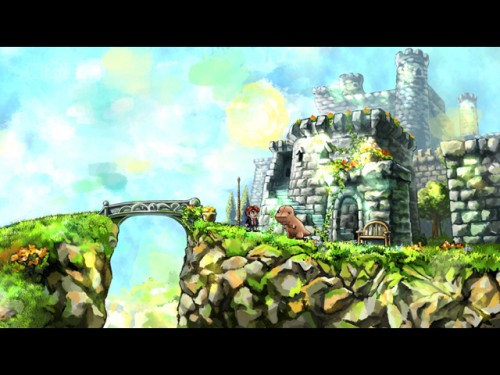
I share the opinion of some that simply calling Braid a ‘casual game’ is a disservice. I think that the moment that Bejeweled became Puzzle Quest, a bridge between ‘casual’ and ‘hardcore’ was formed that has opened up gamers to the possibilities of games like Braid and Plants vs. Zombies and The Path. The great thing about these games is that they are inexpensive enough to allow folks to just grab them for cheap and try them out, which can open them up to an audience not ready to part with $60 so quickly. The other great thing is that they allow even infrequent gamers the opportunity to have a fun and challenging experience without feeling the need to dedicate their life to finishing it quickly.
In some ways I feel that non-hardcore gamers are better suited to deal with the gameplay in some of these games – I found myself being very goal-oriented when starting both The Path and this game, and needing to take a deep breath and just relax in order to really get into them. My kids, however, just took their time and played along and let stuff unfold as it happened. And that is really what you need to do – enjoy what the game is offering without trying to force it to meet your expectations.
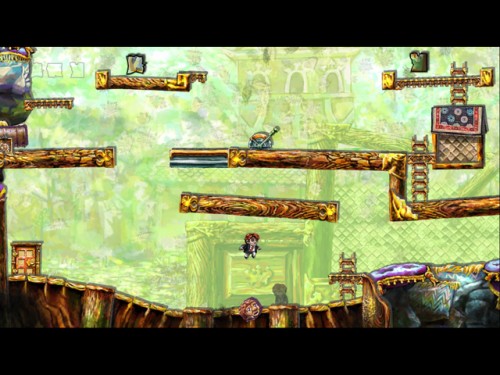
I mentioned The Path specifically, as each game has a pretty obvious ability to get from point A to point B. And similar to The Path, that really isn’t the point of things in Braid. Because underneath the absolutely glorious side-scrolling platform game there is a pretty interesting story that unfolds – there are nuanced bits of symbolism that you start to see from the earliest areas that carry forward and become more coherent as you proceed. So while you are solving the puzzles – and they aren’t too tough but can hang you up quite a bit from time to time – you are also slowly learning the story of the game. It is a wonderful way of wrapping the gameplay and story together and is completely successful in its’ implementation.
I’ve skimmed over the technical stuff, and quite frankly there isn’t a lot to discuss. The game plays out as a 2D side-scrolling platformer, and has a distinctive art style that permeates all of the different worlds you encounter. There is plenty of detail, and the hand drawn visions put forth are proof that a unique style isn’t dependent on pushing tons of pixels. The music is fairly minimal, but works well to create an engaging ambiance.
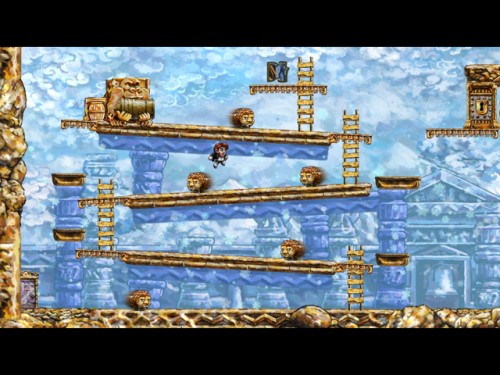
My only complaint is a bit ironic – while the ‘end to end’ game isn’t that long, getting to the true end and seeing how it all comes together requires solving all of the puzzles. I found that has slowed down my progress in what seems like it should have been a quick game. For me it was all worthwhile, but I am willing to bet that the majority of gamers will never see the end, which is a shame.
I really love Braid, and could conclude by saying just that: I love this game and think it is something every gamer should try, and it is priced so low that cost is not a barrier (and for those who pirate these inexpensive one or two person efforts, there is a special place in hell for you!). But I still have some thoughts.
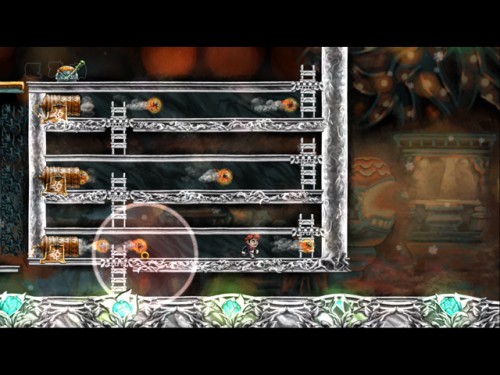
I think we have really seen a renaissance in indie game design and acceptance recently. I have always been a fan of Spiderweb games, where you get 100+ hour games with moral choices, branching dialog and loads of replayability … but late 90’s era graphics and minimal audio. It is all about finding a target audience and making the design choices that work best for your vision. Braid chooses a pretty standard game type, and layer on some subtle plot and artistic elements and a huge gameplay innovation, and comes out with a wonderfully compelling experience – though one that isn’t overly long and has little inherent replayability (not to say that the coolness of the game itself isn’t reason to replay, just that it is the exact same experience over again).
Let me say it again – this is a tremendous game that everyone should at least try. The story is somewhat obscure and difficult to uncover, but what you will experience even if you only play for a few hours will be well worthwhile. Remember that this is truly one of those ‘two guys in a garage’ games, where it is all about someone bringing a vision to life. You have the chance not only to experience a great game, but also to directly support a great developer and also the concept of visionary games over massive corporate efforts formed by focus groups. Not that there needs to be only one or the other, but as more small shops fold or get bought up, it is nice to see such a singular vision be so successful.
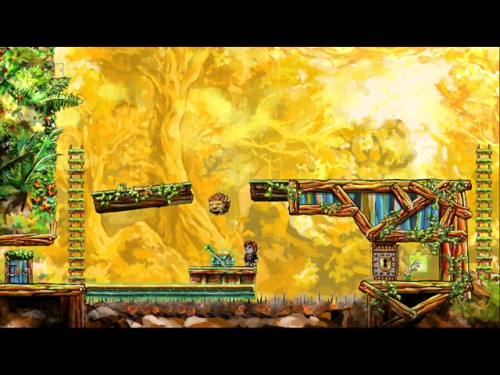
Where to Buy: Buy Braid for PC on Steam
Buy Braid for Mac on Greenhouse Games
Buy Braid for XBLA on XBOX Live Arcade
Price: $14.99
Pros:
+ Wonderfully artistic graphics
+ Simple yet deep gameplay
+ Challenging to uncover everything
+ Budget Price
Cons:
– Most gamers will never see the end.
